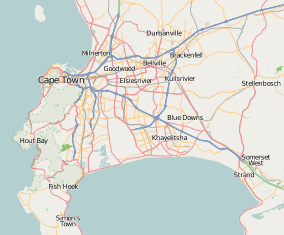Auwal Mosque
| Auwal Mosque | |
|---|---|
|
Auwal Mosque in Bo-Kaap, Cape Town | |
| Location | Bo-Kaap, Cape Town, South Africa. |
| Coordinates | 33°55′15″S 18°24′55″E / 33.92083°S 18.41528°ECoordinates: 33°55′15″S 18°24′55″E / 33.92083°S 18.41528°E |
| Built | 18th century |
| Architectural style(s) | Islamic |
 Location of Auwal Mosque in Cape Town | |
The Auwal Mosque, alternatively spelled Awwal, Owal or Owwal, constructed in 1794, is a mosque in Bo-Kaap, Cape Town, recognised as being the first mosque established in South Africa. The mosque was built on land belonging to the freed slave Coridon van Ceylon.[1] The Coridon's daughter, Saartje van den Caap, inherited the property and donated it for the use as the first mosque, hence the name Owal or Auwal.
Qadi Abdussalam, affectionately known as Tuan Guru, was appointed the first imaam. Tuan Guru was a religious leader who was imprisoned for political reasons. While in prison, he wrote the entire Quran from memory. This Quran is available for viewing at the Auwal mosque. Tuan Guru also used the mosque as a madrassah, "religious" school, where he instructed both children and adults in matters of Islam.
After the demise of Tuan Guru, Saartje van den Caap's husband, Achmad of Bengal, assumed the position of Imaam. This position was to held in the family until 1980 when Imaam Gasan Achmat, officially the last Imaam from this family, died. This position has since been filled by many Imaams including the likes of Sheikh Salih Abadi. Currently, Moulana Mugammad Carr and Sheikh Ismail Londt are joint imaams.
Due to a dispute as to who was to be the next imam of the congregation, a portion of the Auwal congregation split off in 1807 and formed Cape Town's second mosque, the Palm Tree Mosque on Long Street.[2]
See also
References
- ↑ Michael Hutchinson (2006). Bo-Kaap: Colourful Heart of Cape Town. New Africa Books. pp. 3–. ISBN 978-0-86486-693-6. Retrieved 28 September 2012.
- ↑ Nigel Worden; Elizabeth Van Heyningen; Vivian Bickford-Smith (2004). Cape Town: The Making of a City. New Africa Books. pp. 126–. ISBN 978-0-86486-656-1. Retrieved 28 September 2012.
